Swampscott's Neighboring Towns
Item set
- Title
- Description
- Format
- Type
- Coverage
- Contributor
-
Swampscott's Neighboring Towns
-
Images from Swampscott's neighboring towns. This collection includes photos of Nahant, Lynn Woods in Lynn, Mass., and of the great fire in Salem, Mass.
-
image/jpeg
-
still image
-
Photographs
-
Massachusetts--Essex(county)--Swampscott
-
Institution: Swampscott Public Library
Items
-
 Boy passes area destroyed by the Great Salem Fire The Great Salem Fire started at 1:37 PM on June 25, 1914 at the Korn Leather Factory located at 57 Boston Street. Fire departments from the following cities and towns responded to the alarms: Peabody, Lynn, Beverly, Swampscott, Marblehead, Boston, Chelsea, Wakefield, Danvers, Reading, Stoneham, Newburyport, Revere, Lawrence, Malden, Gloucester, Manchester, Medford, Hingham, Somerville, Winchester. In 1914, Salem's population was approximately, 48,000. The city covered 5100 acres and had 5826 buildings with a total valuation of $37,250,000. By the time it was through, "the conflagration [had] burned 253 acres, 1,376 buildings, the territory covered being 1 1/2 miles long by 1/2 mile wide the entire loss probably being much in excess of $15,000,000.00 the insurance loss paid $11,744,000.00, people homeless almost 20,000 and out of work, about 10,000." In the aftermath of the fire, Salem created a rebuilding commission charged with developing new building code and city planning regulations.
Boy passes area destroyed by the Great Salem Fire The Great Salem Fire started at 1:37 PM on June 25, 1914 at the Korn Leather Factory located at 57 Boston Street. Fire departments from the following cities and towns responded to the alarms: Peabody, Lynn, Beverly, Swampscott, Marblehead, Boston, Chelsea, Wakefield, Danvers, Reading, Stoneham, Newburyport, Revere, Lawrence, Malden, Gloucester, Manchester, Medford, Hingham, Somerville, Winchester. In 1914, Salem's population was approximately, 48,000. The city covered 5100 acres and had 5826 buildings with a total valuation of $37,250,000. By the time it was through, "the conflagration [had] burned 253 acres, 1,376 buildings, the territory covered being 1 1/2 miles long by 1/2 mile wide the entire loss probably being much in excess of $15,000,000.00 the insurance loss paid $11,744,000.00, people homeless almost 20,000 and out of work, about 10,000." In the aftermath of the fire, Salem created a rebuilding commission charged with developing new building code and city planning regulations. -
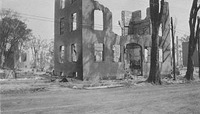 Building destroyed by the Great Salem Fire The Great Salem Fire started at 1:37 PM on June 25, 1914 at the Korn Leather Factory located at 57 Boston Street. Fire departments from the following cities and towns responded to the alarms: Peabody, Lynn, Beverly, Swampscott, Marblehead, Boston, Chelsea, Wakefield, Danvers, Reading, Stoneham, Newburyport, Revere, Lawrence, Malden, Gloucester, Manchester, Medford, Hingham, Somerville, Winchester. In 1914, Salem's population was approximately, 48,000. The city covered 5100 acres and had 5826 buildings with a total valuation of $37,250,000. By the time it was through, "the conflagration [had] burned 253 acres, 1,376 buildings, the territory covered being 1 1/2 miles long by 1/2 mile wide the entire loss probably being much in excess of $15,000,000.00 the insurance loss paid $11,744,000.00, people homeless almost 20,000 and out of work, about 10,000." In the aftermath of the fire, Salem created a rebuilding commission charged with developing new building code and city planning regulations.
Building destroyed by the Great Salem Fire The Great Salem Fire started at 1:37 PM on June 25, 1914 at the Korn Leather Factory located at 57 Boston Street. Fire departments from the following cities and towns responded to the alarms: Peabody, Lynn, Beverly, Swampscott, Marblehead, Boston, Chelsea, Wakefield, Danvers, Reading, Stoneham, Newburyport, Revere, Lawrence, Malden, Gloucester, Manchester, Medford, Hingham, Somerville, Winchester. In 1914, Salem's population was approximately, 48,000. The city covered 5100 acres and had 5826 buildings with a total valuation of $37,250,000. By the time it was through, "the conflagration [had] burned 253 acres, 1,376 buildings, the territory covered being 1 1/2 miles long by 1/2 mile wide the entire loss probably being much in excess of $15,000,000.00 the insurance loss paid $11,744,000.00, people homeless almost 20,000 and out of work, about 10,000." In the aftermath of the fire, Salem created a rebuilding commission charged with developing new building code and city planning regulations. -
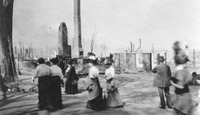 Citizens view wreckage from the Great Salem Fire The Great Salem Fire started at 1:37 PM on June 25, 1914 at the Korn Leather Factory located at 57 Boston Street. Fire departments from the following cities and towns responded to the alarms: Peabody, Lynn, Beverly, Swampscott, Marblehead, Boston, Chelsea, Wakefield, Danvers, Reading, Stoneham, Newburyport, Revere, Lawrence, Malden, Gloucester, Manchester, Medford, Hingham, Somerville, Winchester. In 1914, Salem's population was approximately, 48,000. The city covered 5100 acres and had 5826 buildings with a total valuation of $37,250,000. By the time it was through, "the conflagration [had] burned 253 acres, 1,376 buildings, the territory covered being 1 1/2 miles long by 1/2 mile wide the entire loss probably being much in excess of $15,000,000.00 the insurance loss paid $11,744,000.00, people homeless almost 20,000 and out of work, about 10,000." In the aftermath of the fire, Salem created a rebuilding commission charged with developing new building code and city planning regulations.
Citizens view wreckage from the Great Salem Fire The Great Salem Fire started at 1:37 PM on June 25, 1914 at the Korn Leather Factory located at 57 Boston Street. Fire departments from the following cities and towns responded to the alarms: Peabody, Lynn, Beverly, Swampscott, Marblehead, Boston, Chelsea, Wakefield, Danvers, Reading, Stoneham, Newburyport, Revere, Lawrence, Malden, Gloucester, Manchester, Medford, Hingham, Somerville, Winchester. In 1914, Salem's population was approximately, 48,000. The city covered 5100 acres and had 5826 buildings with a total valuation of $37,250,000. By the time it was through, "the conflagration [had] burned 253 acres, 1,376 buildings, the territory covered being 1 1/2 miles long by 1/2 mile wide the entire loss probably being much in excess of $15,000,000.00 the insurance loss paid $11,744,000.00, people homeless almost 20,000 and out of work, about 10,000." In the aftermath of the fire, Salem created a rebuilding commission charged with developing new building code and city planning regulations. -
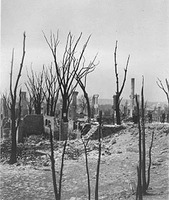 Charred landscape created by the Great Salem Fire The Great Salem Fire started at 1:37 PM on June 25, 1914 at the Korn Leather Factory located at 57 Boston Street. Fire departments from the following cities and towns responded to the alarms: Peabody, Lynn, Beverly, Swampscott, Marblehead, Boston, Chelsea, Wakefield, Danvers, Reading, Stoneham, Newburyport, Revere, Lawrence, Malden, Gloucester, Manchester, Medford, Hingham, Somerville, Winchester. In 1914, Salem's population was approximately, 48,000. The city covered 5100 acres and had 5826 buildings with a total valuation of $37,250,000. By the time it was through, "the conflagration [had] burned 253 acres, 1,376 buildings, the territory covered being 1 1/2 miles long by 1/2 mile wide the entire loss probably being much in excess of $15,000,000.00 the insurance loss paid $11,744,000.00, people homeless almost 20,000 and out of work, about 10,000." In the aftermath of the fire, Salem created a rebuilding commission charged with developing new building code and city planning regulations.
Charred landscape created by the Great Salem Fire The Great Salem Fire started at 1:37 PM on June 25, 1914 at the Korn Leather Factory located at 57 Boston Street. Fire departments from the following cities and towns responded to the alarms: Peabody, Lynn, Beverly, Swampscott, Marblehead, Boston, Chelsea, Wakefield, Danvers, Reading, Stoneham, Newburyport, Revere, Lawrence, Malden, Gloucester, Manchester, Medford, Hingham, Somerville, Winchester. In 1914, Salem's population was approximately, 48,000. The city covered 5100 acres and had 5826 buildings with a total valuation of $37,250,000. By the time it was through, "the conflagration [had] burned 253 acres, 1,376 buildings, the territory covered being 1 1/2 miles long by 1/2 mile wide the entire loss probably being much in excess of $15,000,000.00 the insurance loss paid $11,744,000.00, people homeless almost 20,000 and out of work, about 10,000." In the aftermath of the fire, Salem created a rebuilding commission charged with developing new building code and city planning regulations. -
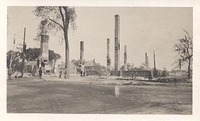 Destruction from the Great Salem Fire The Great Salem Fire started at 1:37 PM on June 25, 1914 at the Korn Leather Factory located at 57 Boston Street. Fire departments from the following cities and towns responded to the alarms: Peabody, Lynn, Beverly, Swampscott, Marblehead, Boston, Chelsea, Wakefield, Danvers, Reading, Stoneham, Newburyport, Revere, Lawrence, Malden, Gloucester, Manchester, Medford, Hingham, Somerville, Winchester. In 1914, Salem's population was approximately, 48,000. The city covered 5100 acres and had 5826 buildings with a total valuation of $37,250,000. By the time it was through, "the conflagration [had] burned 253 acres, 1,376 buildings, the territory covered being 1 1/2 miles long by 1/2 mile wide the entire loss probably being much in excess of $15,000,000.00 the insurance loss paid $11,744,000.00, people homeless almost 20,000 and out of work, about 10,000." In the aftermath of the fire, Salem created a rebuilding commission charged with developing new building code and city planning regulations.
Destruction from the Great Salem Fire The Great Salem Fire started at 1:37 PM on June 25, 1914 at the Korn Leather Factory located at 57 Boston Street. Fire departments from the following cities and towns responded to the alarms: Peabody, Lynn, Beverly, Swampscott, Marblehead, Boston, Chelsea, Wakefield, Danvers, Reading, Stoneham, Newburyport, Revere, Lawrence, Malden, Gloucester, Manchester, Medford, Hingham, Somerville, Winchester. In 1914, Salem's population was approximately, 48,000. The city covered 5100 acres and had 5826 buildings with a total valuation of $37,250,000. By the time it was through, "the conflagration [had] burned 253 acres, 1,376 buildings, the territory covered being 1 1/2 miles long by 1/2 mile wide the entire loss probably being much in excess of $15,000,000.00 the insurance loss paid $11,744,000.00, people homeless almost 20,000 and out of work, about 10,000." In the aftermath of the fire, Salem created a rebuilding commission charged with developing new building code and city planning regulations. -
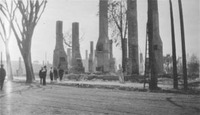 Citizens view destruction from the Great Salem Fire The Great Salem Fire started at 1:37 PM on June 25, 1914 at the Korn Leather Factory located at 57 Boston Street. Fire departments from the following cities and towns responded to the alarms: Peabody, Lynn, Beverly, Swampscott, Marblehead, Boston, Chelsea, Wakefield, Danvers, Reading, Stoneham, Newburyport, Revere, Lawrence, Malden, Gloucester, Manchester, Medford, Hingham, Somerville, Winchester. In 1914, Salem's population was approximately, 48,000. The city covered 5100 acres and had 5826 buildings with a total valuation of $37,250,000. By the time it was through, "the conflagration [had] burned 253 acres, 1,376 buildings, the territory covered being 1 1/2 miles long by 1/2 mile wide the entire loss probably being much in excess of $15,000,000.00 the insurance loss paid $11,744,000.00, people homeless almost 20,000 and out of work, about 10,000." In the aftermath of the fire, Salem created a rebuilding commission charged with developing new building code and city planning regulations.
Citizens view destruction from the Great Salem Fire The Great Salem Fire started at 1:37 PM on June 25, 1914 at the Korn Leather Factory located at 57 Boston Street. Fire departments from the following cities and towns responded to the alarms: Peabody, Lynn, Beverly, Swampscott, Marblehead, Boston, Chelsea, Wakefield, Danvers, Reading, Stoneham, Newburyport, Revere, Lawrence, Malden, Gloucester, Manchester, Medford, Hingham, Somerville, Winchester. In 1914, Salem's population was approximately, 48,000. The city covered 5100 acres and had 5826 buildings with a total valuation of $37,250,000. By the time it was through, "the conflagration [had] burned 253 acres, 1,376 buildings, the territory covered being 1 1/2 miles long by 1/2 mile wide the entire loss probably being much in excess of $15,000,000.00 the insurance loss paid $11,744,000.00, people homeless almost 20,000 and out of work, about 10,000." In the aftermath of the fire, Salem created a rebuilding commission charged with developing new building code and city planning regulations. -
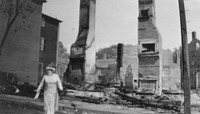 Great Salem Fire : chimneys of destroyed building The Great Salem Fire started at 1:37 PM on June 25, 1914 at the Korn Leather Factory located at 57 Boston Street. Fire departments from the following cities and towns responded to the alarms: Peabody, Lynn, Beverly, Swampscott, Marblehead, Boston, Chelsea, Wakefield, Danvers, Reading, Stoneham, Newburyport, Revere, Lawrence, Malden, Gloucester, Manchester, Medford, Hingham, Somerville, Winchester. In 1914, Salem's population was approximately, 48,000. The city covered 5100 acres and had 5826 buildings with a total valuation of $37,250,000. By the time it was through, "the conflagration [had] burned 253 acres, 1,376 buildings, the territory covered being 1 1/2 miles long by 1/2 mile wide the entire loss probably being much in excess of $15,000,000.00 the insurance loss paid $11,744,000.00, people homeless almost 20,000 and out of work, about 10,000." In the aftermath of the fire, Salem created a rebuilding commission charged with developing new building code and city planning regulations.
Great Salem Fire : chimneys of destroyed building The Great Salem Fire started at 1:37 PM on June 25, 1914 at the Korn Leather Factory located at 57 Boston Street. Fire departments from the following cities and towns responded to the alarms: Peabody, Lynn, Beverly, Swampscott, Marblehead, Boston, Chelsea, Wakefield, Danvers, Reading, Stoneham, Newburyport, Revere, Lawrence, Malden, Gloucester, Manchester, Medford, Hingham, Somerville, Winchester. In 1914, Salem's population was approximately, 48,000. The city covered 5100 acres and had 5826 buildings with a total valuation of $37,250,000. By the time it was through, "the conflagration [had] burned 253 acres, 1,376 buildings, the territory covered being 1 1/2 miles long by 1/2 mile wide the entire loss probably being much in excess of $15,000,000.00 the insurance loss paid $11,744,000.00, people homeless almost 20,000 and out of work, about 10,000." In the aftermath of the fire, Salem created a rebuilding commission charged with developing new building code and city planning regulations. -
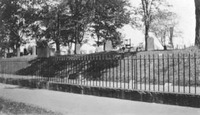 View of a cemetery after the Great Salem Fire The Great Salem Fire started at 1:37 PM on June 25, 1914 at the Korn Leather Factory located at 57 Boston Street. Fire departments from the following cities and towns responded to the alarms: Peabody, Lynn, Beverly, Swampscott, Marblehead, Boston, Chelsea, Wakefield, Danvers, Reading, Stoneham, Newburyport, Revere, Lawrence, Malden, Gloucester, Manchester, Medford, Hingham, Somerville, Winchester. In 1914, Salem's population was approximately, 48,000. The city covered 5100 acres and had 5826 buildings with a total valuation of $37,250,000. By the time it was through, "the conflagration [had] burned 253 acres, 1,376 buildings, the territory covered being 1 1/2 miles long by 1/2 mile wide the entire loss probably being much in excess of $15,000,000.00 the insurance loss paid $11,744,000.00, people homeless almost 20,000 and out of work, about 10,000." In the aftermath of the fire, Salem created a rebuilding commission charged with developing new building code and city planning regulations.
View of a cemetery after the Great Salem Fire The Great Salem Fire started at 1:37 PM on June 25, 1914 at the Korn Leather Factory located at 57 Boston Street. Fire departments from the following cities and towns responded to the alarms: Peabody, Lynn, Beverly, Swampscott, Marblehead, Boston, Chelsea, Wakefield, Danvers, Reading, Stoneham, Newburyport, Revere, Lawrence, Malden, Gloucester, Manchester, Medford, Hingham, Somerville, Winchester. In 1914, Salem's population was approximately, 48,000. The city covered 5100 acres and had 5826 buildings with a total valuation of $37,250,000. By the time it was through, "the conflagration [had] burned 253 acres, 1,376 buildings, the territory covered being 1 1/2 miles long by 1/2 mile wide the entire loss probably being much in excess of $15,000,000.00 the insurance loss paid $11,744,000.00, people homeless almost 20,000 and out of work, about 10,000." In the aftermath of the fire, Salem created a rebuilding commission charged with developing new building code and city planning regulations. -
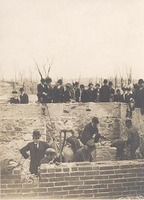 Great Salem Fire : surveying damage The Great Salem Fire started at 1:37 PM on June 25, 1914 at the Korn Leather Factory located at 57 Boston Street. Fire departments from the following cities and towns responded to the alarms: Peabody, Lynn, Beverly, Swampscott, Marblehead, Boston, Chelsea, Wakefield, Danvers, Reading, Stoneham, Newburyport, Revere, Lawrence, Malden, Gloucester, Manchester, Medford, Hingham, Somerville, Winchester. In 1914, Salem's population was approximately, 48,000. The city covered 5100 acres and had 5826 buildings with a total valuation of $37,250,000. By the time it was through, "the conflagration [had] burned 253 acres, 1,376 buildings, the territory covered being 1 1/2 miles long by 1/2 mile wide the entire loss probably being much in excess of $15,000,000.00 the insurance loss paid $11,744,000.00, people homeless almost 20,000 and out of work, about 10,000." In the aftermath of the fire, Salem created a rebuilding commission charged with developing new building code and city planning regulations.
Great Salem Fire : surveying damage The Great Salem Fire started at 1:37 PM on June 25, 1914 at the Korn Leather Factory located at 57 Boston Street. Fire departments from the following cities and towns responded to the alarms: Peabody, Lynn, Beverly, Swampscott, Marblehead, Boston, Chelsea, Wakefield, Danvers, Reading, Stoneham, Newburyport, Revere, Lawrence, Malden, Gloucester, Manchester, Medford, Hingham, Somerville, Winchester. In 1914, Salem's population was approximately, 48,000. The city covered 5100 acres and had 5826 buildings with a total valuation of $37,250,000. By the time it was through, "the conflagration [had] burned 253 acres, 1,376 buildings, the territory covered being 1 1/2 miles long by 1/2 mile wide the entire loss probably being much in excess of $15,000,000.00 the insurance loss paid $11,744,000.00, people homeless almost 20,000 and out of work, about 10,000." In the aftermath of the fire, Salem created a rebuilding commission charged with developing new building code and city planning regulations. -
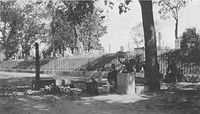 Men outside of a cemetery after the Great Salem Fire The Great Salem Fire started at 1:37 PM on June 25, 1914 at the Korn Leather Factory located at 57 Boston Street. Fire departments from the following cities and towns responded to the alarms: Peabody, Lynn, Beverly, Swampscott, Marblehead, Boston, Chelsea, Wakefield, Danvers, Reading, Stoneham, Newburyport, Revere, Lawrence, Malden, Gloucester, Manchester, Medford, Hingham, Somerville, Winchester. In 1914, Salem's population was approximately, 48,000. The city covered 5100 acres and had 5826 buildings with a total valuation of $37,250,000. By the time it was through, "the conflagration [had] burned 253 acres, 1,376 buildings, the territory covered being 1 1/2 miles long by 1/2 mile wide the entire loss probably being much in excess of $15,000,000.00 the insurance loss paid $11,744,000.00, people homeless almost 20,000 and out of work, about 10,000." In the aftermath of the fire, Salem created a rebuilding commission charged with developing new building code and city planning regulations.
Men outside of a cemetery after the Great Salem Fire The Great Salem Fire started at 1:37 PM on June 25, 1914 at the Korn Leather Factory located at 57 Boston Street. Fire departments from the following cities and towns responded to the alarms: Peabody, Lynn, Beverly, Swampscott, Marblehead, Boston, Chelsea, Wakefield, Danvers, Reading, Stoneham, Newburyport, Revere, Lawrence, Malden, Gloucester, Manchester, Medford, Hingham, Somerville, Winchester. In 1914, Salem's population was approximately, 48,000. The city covered 5100 acres and had 5826 buildings with a total valuation of $37,250,000. By the time it was through, "the conflagration [had] burned 253 acres, 1,376 buildings, the territory covered being 1 1/2 miles long by 1/2 mile wide the entire loss probably being much in excess of $15,000,000.00 the insurance loss paid $11,744,000.00, people homeless almost 20,000 and out of work, about 10,000." In the aftermath of the fire, Salem created a rebuilding commission charged with developing new building code and city planning regulations. -
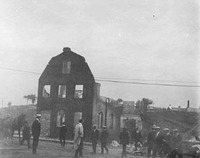 Citizens inspect a building destoyed in the Great Salem Fire The Great Salem Fire started at 1:37 PM on June 25, 1914 at the Korn Leather Factory located at 57 Boston Street. Fire departments from the following cities and towns responded to the alarms: Peabody, Lynn, Beverly, Swampscott, Marblehead, Boston, Chelsea, Wakefield, Danvers, Reading, Stoneham, Newburyport, Revere, Lawrence, Malden, Gloucester, Manchester, Medford, Hingham, Somerville, Winchester. In 1914, Salem's population was approximately, 48,000. The city covered 5100 acres and had 5826 buildings with a total valuation of $37,250,000. By the time it was through, "the conflagration [had] burned 253 acres, 1,376 buildings, the territory covered being 1 1/2 miles long by 1/2 mile wide the entire loss probably being much in excess of $15,000,000.00 the insurance loss paid $11,744,000.00, people homeless almost 20,000 and out of work, about 10,000." In the aftermath of the fire, Salem created a rebuilding commission charged with developing new building code and city planning regulations.
Citizens inspect a building destoyed in the Great Salem Fire The Great Salem Fire started at 1:37 PM on June 25, 1914 at the Korn Leather Factory located at 57 Boston Street. Fire departments from the following cities and towns responded to the alarms: Peabody, Lynn, Beverly, Swampscott, Marblehead, Boston, Chelsea, Wakefield, Danvers, Reading, Stoneham, Newburyport, Revere, Lawrence, Malden, Gloucester, Manchester, Medford, Hingham, Somerville, Winchester. In 1914, Salem's population was approximately, 48,000. The city covered 5100 acres and had 5826 buildings with a total valuation of $37,250,000. By the time it was through, "the conflagration [had] burned 253 acres, 1,376 buildings, the territory covered being 1 1/2 miles long by 1/2 mile wide the entire loss probably being much in excess of $15,000,000.00 the insurance loss paid $11,744,000.00, people homeless almost 20,000 and out of work, about 10,000." In the aftermath of the fire, Salem created a rebuilding commission charged with developing new building code and city planning regulations. -
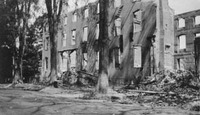 Remains of a building destroyed in the Great Salem Fire The Great Salem Fire started at 1:37 PM on June 25, 1914 at the Korn Leather Factory located at 57 Boston Street. Fire departments from the following cities and towns responded to the alarms: Peabody, Lynn, Beverly, Swampscott, Marblehead, Boston, Chelsea, Wakefield, Danvers, Reading, Stoneham, Newburyport, Revere, Lawrence, Malden, Gloucester, Manchester, Medford, Hingham, Somerville, Winchester. In 1914, Salem's population was approximately, 48,000. The city covered 5100 acres and had 5826 buildings with a total valuation of $37,250,000. By the time it was through, "the conflagration [had] burned 253 acres, 1,376 buildings, the territory covered being 1 1/2 miles long by 1/2 mile wide the entire loss probably being much in excess of $15,000,000.00 the insurance loss paid $11,744,000.00, people homeless almost 20,000 and out of work, about 10,000." In the aftermath of the fire, Salem created a rebuilding commission charged with developing new building code and city planning regulations.
Remains of a building destroyed in the Great Salem Fire The Great Salem Fire started at 1:37 PM on June 25, 1914 at the Korn Leather Factory located at 57 Boston Street. Fire departments from the following cities and towns responded to the alarms: Peabody, Lynn, Beverly, Swampscott, Marblehead, Boston, Chelsea, Wakefield, Danvers, Reading, Stoneham, Newburyport, Revere, Lawrence, Malden, Gloucester, Manchester, Medford, Hingham, Somerville, Winchester. In 1914, Salem's population was approximately, 48,000. The city covered 5100 acres and had 5826 buildings with a total valuation of $37,250,000. By the time it was through, "the conflagration [had] burned 253 acres, 1,376 buildings, the territory covered being 1 1/2 miles long by 1/2 mile wide the entire loss probably being much in excess of $15,000,000.00 the insurance loss paid $11,744,000.00, people homeless almost 20,000 and out of work, about 10,000." In the aftermath of the fire, Salem created a rebuilding commission charged with developing new building code and city planning regulations. -
 Bass Point House : 6 The Bass Point House was one of several resort hotels located in Nahant, Massachusetts, which became a popular vacation destination from the 1820's on. This photo shows a side view of the hotel, with a two story porch with a sign in large letters saying dancing above the porch. The wharf is also visible on the left, with the beach in the foreground.
Bass Point House : 6 The Bass Point House was one of several resort hotels located in Nahant, Massachusetts, which became a popular vacation destination from the 1820's on. This photo shows a side view of the hotel, with a two story porch with a sign in large letters saying dancing above the porch. The wharf is also visible on the left, with the beach in the foreground. -
 Bass Point House : 5 The Bass Point House was one of several resort hotels located in Nahant, Massachusetts, which became a popular vacation destination from the 1820's on. This photo, which is almost identical to photo #4, shows a side view of the hotel, with a two story porch bearing a sign Bass Point House, as well as a smaller sign saying auction, on the top. There is also a large sign painted on the body of the hotel with the words Bass Point House, Jas. I. Purcell, Prop.
Bass Point House : 5 The Bass Point House was one of several resort hotels located in Nahant, Massachusetts, which became a popular vacation destination from the 1820's on. This photo, which is almost identical to photo #4, shows a side view of the hotel, with a two story porch bearing a sign Bass Point House, as well as a smaller sign saying auction, on the top. There is also a large sign painted on the body of the hotel with the words Bass Point House, Jas. I. Purcell, Prop. -
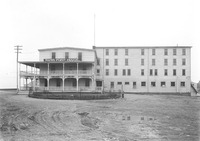 Bass Point House : 4 The Bass Point House was one of several resort hotels located in Nahant, Massachusetts, which became a popular vacation destination from the 1820's on. This photo shows a side view of the hotel, with a two story porch bearing a sign Bass Point House on the top.
Bass Point House : 4 The Bass Point House was one of several resort hotels located in Nahant, Massachusetts, which became a popular vacation destination from the 1820's on. This photo shows a side view of the hotel, with a two story porch bearing a sign Bass Point House on the top. -
 Bass Point House : 3 The Bass Point House was one of several resort hotels located in Nahant, Massachusetts, which became a popular vacation destination from the 1820's on. This photo is taken from the road leading up to the hotel, and shows the entire hotel on the right, along with the beach. Another building, which could be an amusement arcade, is located on the left.
Bass Point House : 3 The Bass Point House was one of several resort hotels located in Nahant, Massachusetts, which became a popular vacation destination from the 1820's on. This photo is taken from the road leading up to the hotel, and shows the entire hotel on the right, along with the beach. Another building, which could be an amusement arcade, is located on the left. -
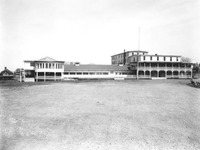 Bass Point House : 2 The Bass Point House was one of several resort hotels located in the Bass Point section of Nahant, Massachusetts, which became a popular vacation destination from the 1820's on. This photo is a panoramic picture showing the road leading up to the hotel.
Bass Point House : 2 The Bass Point House was one of several resort hotels located in the Bass Point section of Nahant, Massachusetts, which became a popular vacation destination from the 1820's on. This photo is a panoramic picture showing the road leading up to the hotel. -
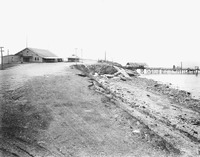 Bass Point House : 1 The Bass Point House was one of several resort hotels located in Nahant, Massachusetts, which became a popular vacation destination from the 1820's on. This photo shows a wooden wharf on the right and the rear of the hotel to the left.
Bass Point House : 1 The Bass Point House was one of several resort hotels located in Nahant, Massachusetts, which became a popular vacation destination from the 1820's on. This photo shows a wooden wharf on the right and the rear of the hotel to the left. -
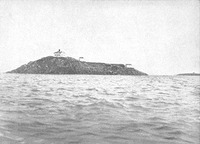 Egg Rock Light Egg Rock is a little less than a mile northeast of the town of Nahant. The three-acre island is about 80 feet high and can be seen from many locations north of Boston, from Winthrop to Marblehead. The first lighthouse was built on Egg Rock in 1856 with Congressional funding. The lighthouse was considered essential in guiding Swampscott's growing fishing fleet safely to port. "The lighthouse's fifth-order Fresnel lens produced a fixed white light, first exhibited on September 15, 1856. It was changed to red a year later in reaction to the wreck of the schooner Shark, whose captain had mistaken Egg Rock Light for Long Island Head Light in Boston Harbor." After a fire, "the lighthouse was rebuilt in 1897 with the addition of an oil house in 1904, and a new pier and boat house in 1906. During World War I, the light at Egg Rock was dimmed because of fears of enemy submarines in the area. By 1919, an automatic gas-operated beacon was placed in the tower, but in 1922, the light was discontinued. The government sold the buildings at auction for $160, requiring the new owner to remove the buildings from the island. During this move, a cable snapped and the house tumbled into the ocean. Today, Egg Rock is the home of the Henry Cabot Lodge wildlife sanctuary.--from New England Lighthouses : a virtual guide, viewed 03-17-2008.
Egg Rock Light Egg Rock is a little less than a mile northeast of the town of Nahant. The three-acre island is about 80 feet high and can be seen from many locations north of Boston, from Winthrop to Marblehead. The first lighthouse was built on Egg Rock in 1856 with Congressional funding. The lighthouse was considered essential in guiding Swampscott's growing fishing fleet safely to port. "The lighthouse's fifth-order Fresnel lens produced a fixed white light, first exhibited on September 15, 1856. It was changed to red a year later in reaction to the wreck of the schooner Shark, whose captain had mistaken Egg Rock Light for Long Island Head Light in Boston Harbor." After a fire, "the lighthouse was rebuilt in 1897 with the addition of an oil house in 1904, and a new pier and boat house in 1906. During World War I, the light at Egg Rock was dimmed because of fears of enemy submarines in the area. By 1919, an automatic gas-operated beacon was placed in the tower, but in 1922, the light was discontinued. The government sold the buildings at auction for $160, requiring the new owner to remove the buildings from the island. During this move, a cable snapped and the house tumbled into the ocean. Today, Egg Rock is the home of the Henry Cabot Lodge wildlife sanctuary.--from New England Lighthouses : a virtual guide, viewed 03-17-2008. -
 Nahant cottage Photo shows a large "cottage" in Nahant, Massachusetts on what is now the present site of the Nahant Country Club.
Nahant cottage Photo shows a large "cottage" in Nahant, Massachusetts on what is now the present site of the Nahant Country Club. -
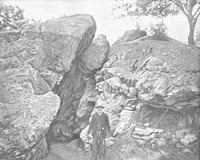 Dungeon Rock, Lynn Woods "Late in the summer of 1658, a sinister ship appeared in Lynn Harbor. The ship was painted black and flew no flag. Word spread quickly among the citizens of the small town of Lynn, Massachusetts: There were pirates in the harbor! A boat was lowered from the ship, a chest was loaded into the boat, and four oarsmen rowed it toward shore. The boat headed up the Saugus River and landed near the Saugus Iron Works. The next day, workers found a note attached to a door, asking to purchase a supply of shackles, hatchets, shovels, and other tools. The note promised that if the requested tools were manufactured and left at a secret location, then a supply of silver would be left in exchange. The tools were made and paid for as promised. The pirates made camp in a place now known as Pirate's Glen near the Saugus River. British soldiers stationed nearby heard about the pirates and set off to capture them. Three of the buccaneers were captured and hanged but the forth, Thomas Veal, escaped into the woods. It was believed that he took the stolen hoard with him as he headed deeper and deeper into the woods, finally arriving at a natural cave in what is now Lynn Woods. Veal lived in the cave for some time and became a member of the Lynn community. The story says he mended shoes for spending money and lived in relative peace with his neighbors. Suddenly, an earthquake rocked the Lynn area, causing a gigantic piece of the rock to tip forward and permanently seal the cave opening. Poor Veal was either trapped inside or crushed to death with his treasure, locked forever in Dungeon Rock. The remains of Thomas Veal and his treasure were left undisturbed for nearly two hundred years.
Dungeon Rock, Lynn Woods "Late in the summer of 1658, a sinister ship appeared in Lynn Harbor. The ship was painted black and flew no flag. Word spread quickly among the citizens of the small town of Lynn, Massachusetts: There were pirates in the harbor! A boat was lowered from the ship, a chest was loaded into the boat, and four oarsmen rowed it toward shore. The boat headed up the Saugus River and landed near the Saugus Iron Works. The next day, workers found a note attached to a door, asking to purchase a supply of shackles, hatchets, shovels, and other tools. The note promised that if the requested tools were manufactured and left at a secret location, then a supply of silver would be left in exchange. The tools were made and paid for as promised. The pirates made camp in a place now known as Pirate's Glen near the Saugus River. British soldiers stationed nearby heard about the pirates and set off to capture them. Three of the buccaneers were captured and hanged but the forth, Thomas Veal, escaped into the woods. It was believed that he took the stolen hoard with him as he headed deeper and deeper into the woods, finally arriving at a natural cave in what is now Lynn Woods. Veal lived in the cave for some time and became a member of the Lynn community. The story says he mended shoes for spending money and lived in relative peace with his neighbors. Suddenly, an earthquake rocked the Lynn area, causing a gigantic piece of the rock to tip forward and permanently seal the cave opening. Poor Veal was either trapped inside or crushed to death with his treasure, locked forever in Dungeon Rock. The remains of Thomas Veal and his treasure were left undisturbed for nearly two hundred years. -
 Breed's Pond, Lynn, Massachusetts Photo shows Breeds Pond in Lynn, Massachusetts, located off of Parkland Avenue at the edge of the Lynn Woods Reservation. The photo shows the pond on the left surrounded by woods.
Breed's Pond, Lynn, Massachusetts Photo shows Breeds Pond in Lynn, Massachusetts, located off of Parkland Avenue at the edge of the Lynn Woods Reservation. The photo shows the pond on the left surrounded by woods. -
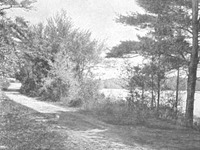 Spring Pond, Lynn, Massachusetts Photo shows Spring Pond in Lynn, Massachusetts, located off of Spring Pond Road on the Lynn/Peabody line. There is a road running through the picture with the pond on the right and woods on the left.
Spring Pond, Lynn, Massachusetts Photo shows Spring Pond in Lynn, Massachusetts, located off of Spring Pond Road on the Lynn/Peabody line. There is a road running through the picture with the pond on the right and woods on the left. -
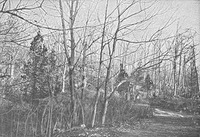 Paradise Woods Photo shows a wooded area, called Paradise Woods, located off Paradise Road in Swampscott, Massachusetts.
Paradise Woods Photo shows a wooded area, called Paradise Woods, located off Paradise Road in Swampscott, Massachusetts. -
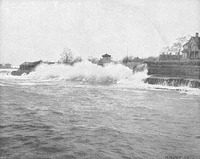 Surf on Lynn breakwater Photo shows surf crashing along the shore in Lynn, Massachusetts. There is a house located to the right in the picture.
Surf on Lynn breakwater Photo shows surf crashing along the shore in Lynn, Massachusetts. There is a house located to the right in the picture. -
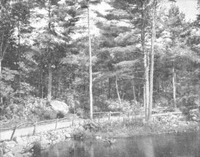 Lynn Woods (?), Lynn, Massachusetts Photo shows an unidentified park (Lynn Woods?) in the City of Lynn, Massachusetts. There is a road running through the picture with water in the foreground and woods in the background.
Lynn Woods (?), Lynn, Massachusetts Photo shows an unidentified park (Lynn Woods?) in the City of Lynn, Massachusetts. There is a road running through the picture with water in the foreground and woods in the background. -
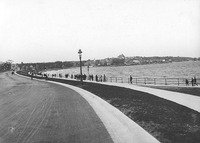 Lynn Shore Drive View looking north along Lynn Shore Drive. People stroll along the sidewalk overlooing the ocean on the right.
Lynn Shore Drive View looking north along Lynn Shore Drive. People stroll along the sidewalk overlooing the ocean on the right. -
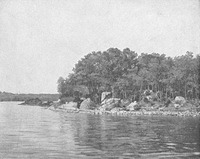 Walden Pond, Lynn, Mass. View across Walden Pond, also known as Lake Walden, to the rocky, tree-covered shore.
Walden Pond, Lynn, Mass. View across Walden Pond, also known as Lake Walden, to the rocky, tree-covered shore. -
 Maple Street, Lynn, Massachusetts Photo shows a dirt road with what appears to be a chicken coop in front and a house at the rear.
Maple Street, Lynn, Massachusetts Photo shows a dirt road with what appears to be a chicken coop in front and a house at the rear.
